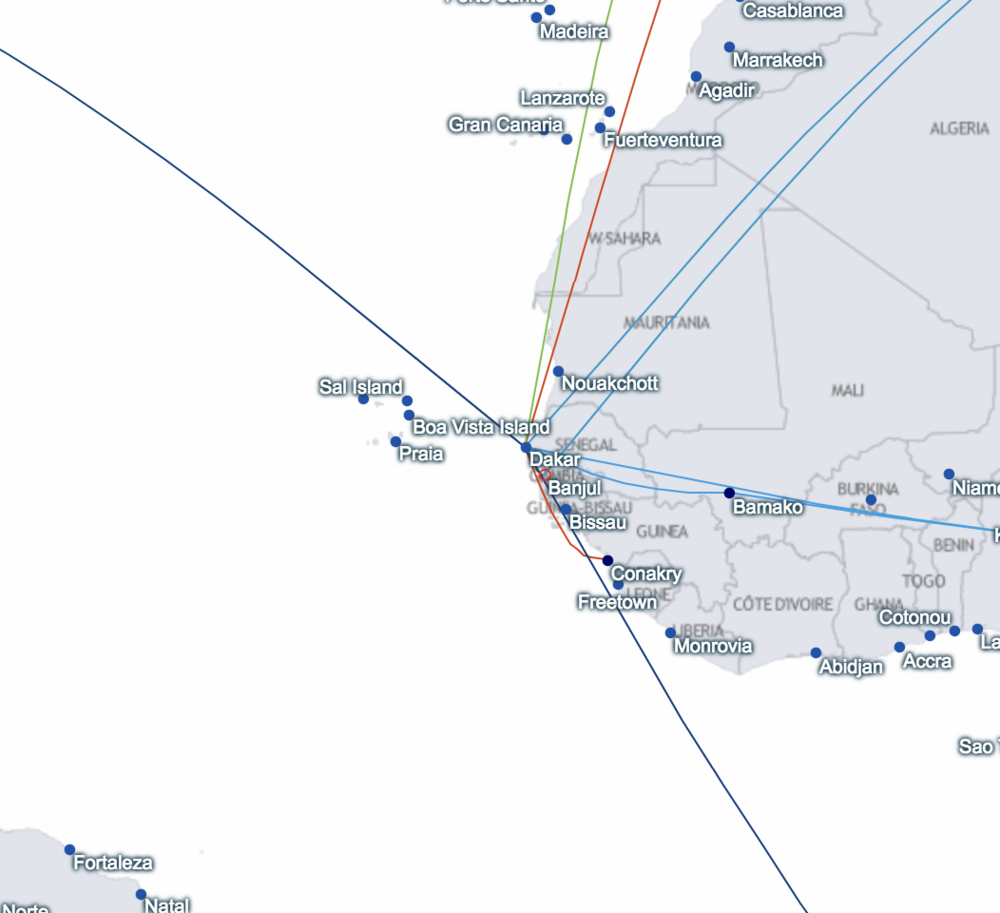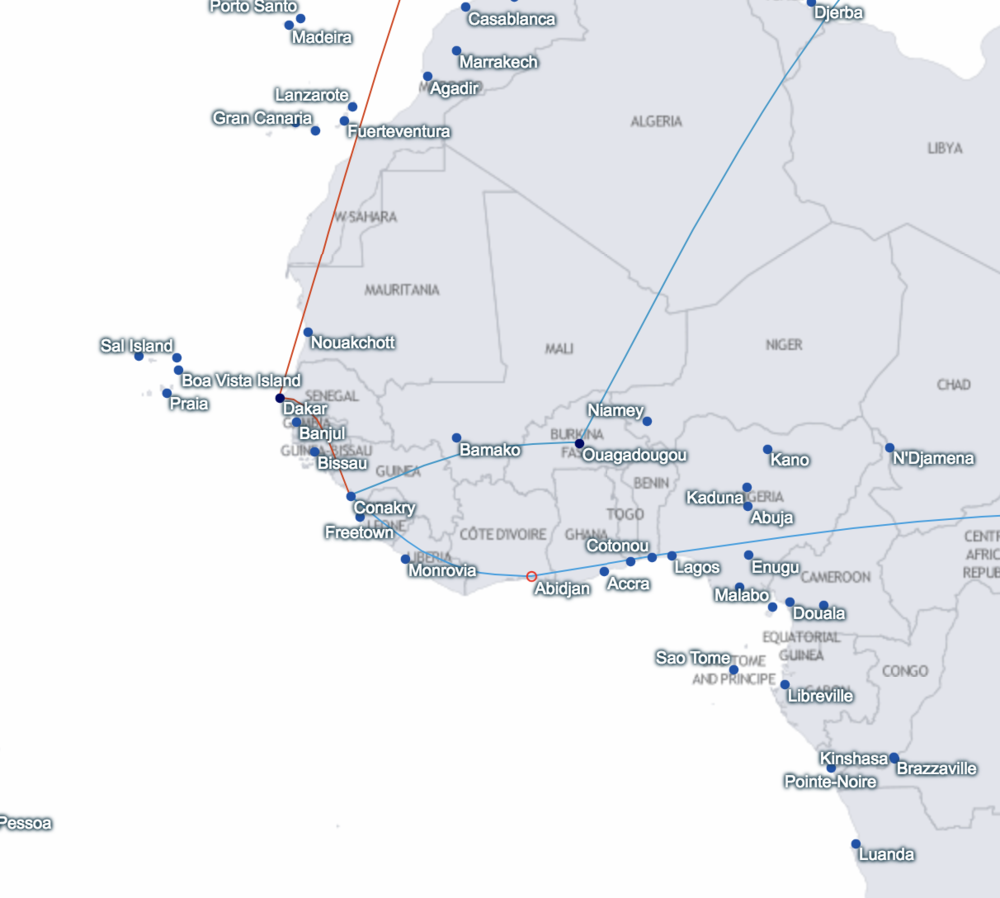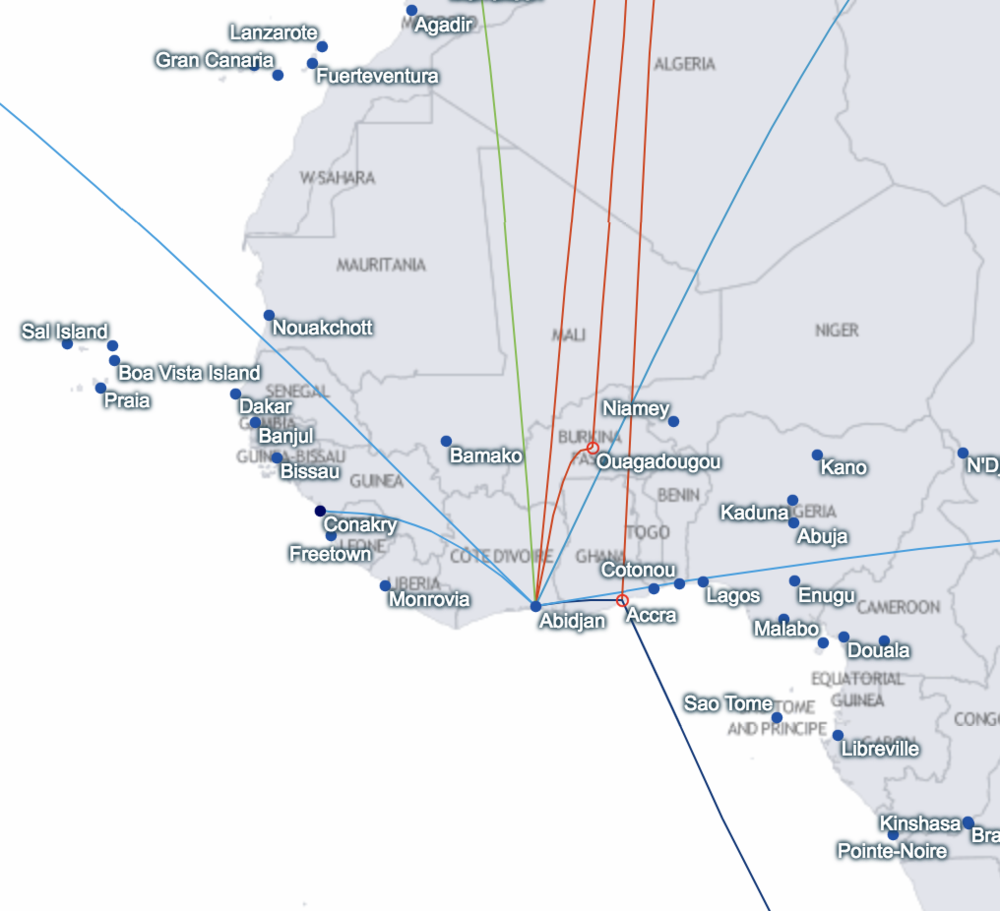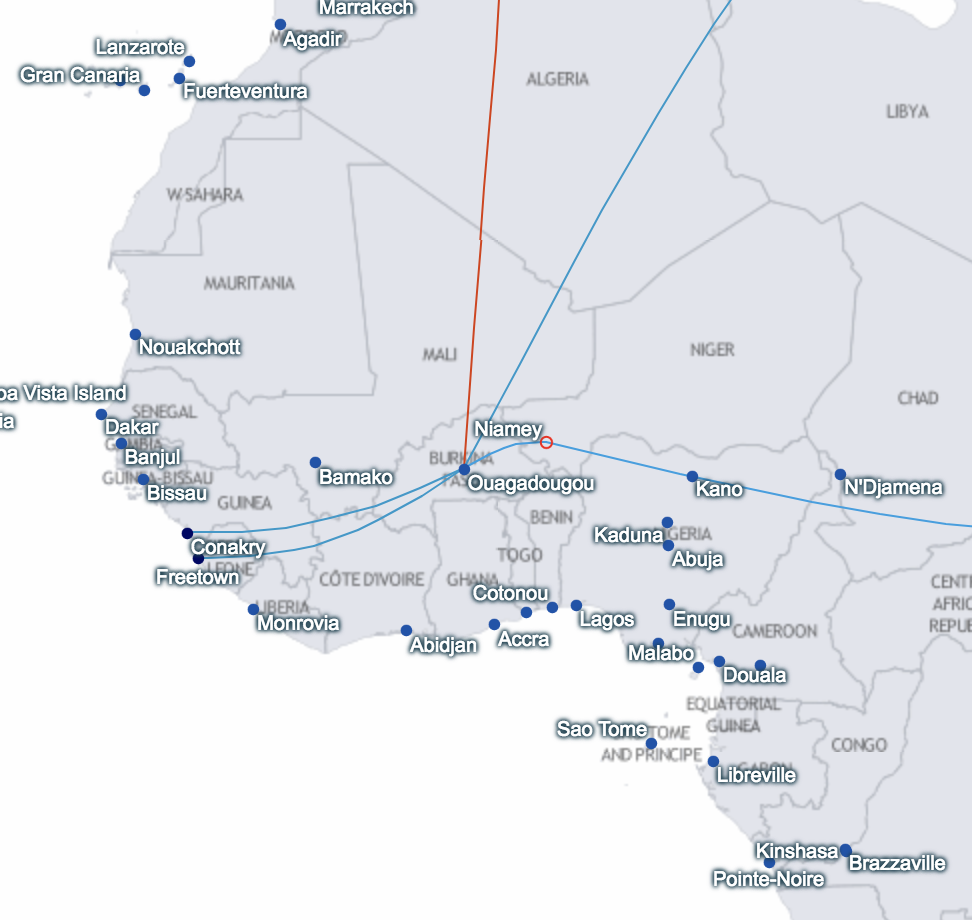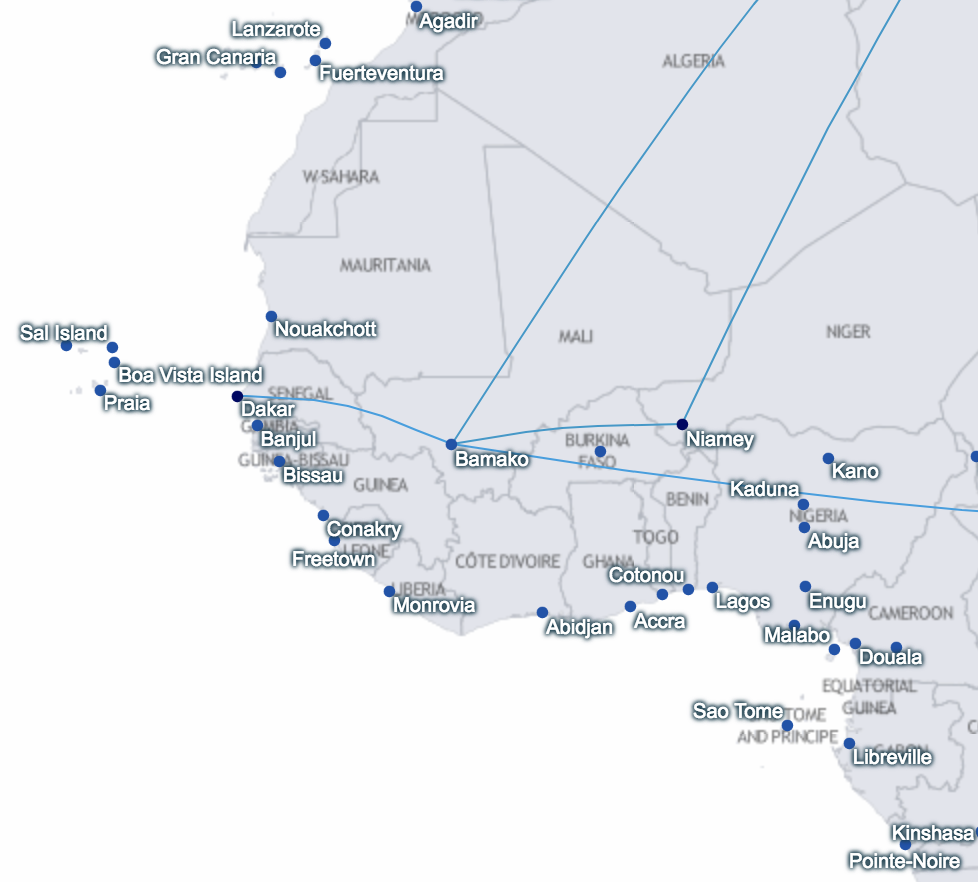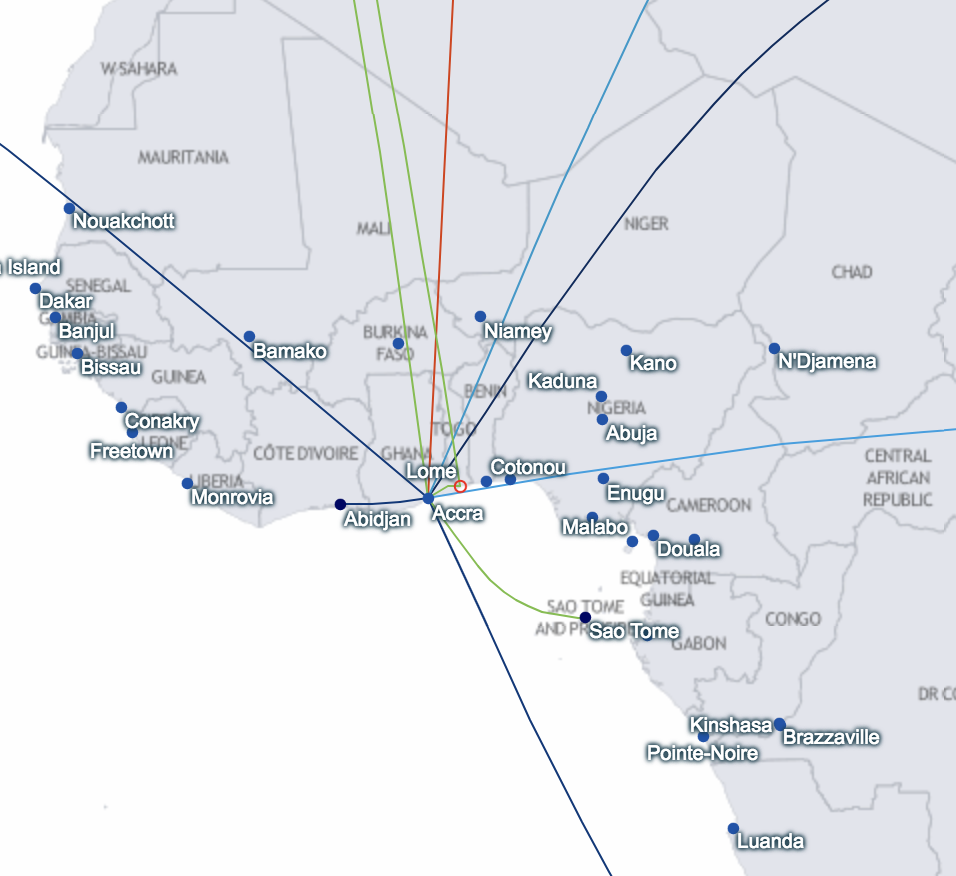My dear readers. You’ve listened to me rant and rave about maximizing the value of your Aeroplan miles using stopovers, crazy routings, and long layovers. Well, it’s about time that I practice what I preach.
Recently I’ve been planning an extremely complex Aeroplan booking for a trip that I’m taking next year. And now that it’s fully booked, I thought it’d be instructive to share with you the details (even though the trip is many months away) in order to walk you through my workflow when it comes to putting together a byzantine itinerary like this.
Given the upcoming separation from Air Canada in 2020 and the uncertainty of the program after that, I figured that the clock was ticking if I wanted to take advantage of some of the crazy things that Aeroplan lets you do. So while the main purpose of the trip is to go back to Beijing to visit my family for Chinese New Year 2019, I wanted to simultaneously use this opportunity to “take Aeroplan for a ride”. My goals were, roughly speaking, as follows:
Have a one-week stopover in Beijing for Chinese New Year
Fly around the world a lot, ideally in business class
Visit some out-of-the-way places that are allowed by Aeroplan’s generous routing rules; the more out-of-the-way, the better
Initial Considerations
If you’re familiar with how Aeroplan’s maximum permitted mileage (MPM) rules work, you’ll know that the farther the distance between your origin and destination, the higher your MPM, and therefore the more flying you’re allowed to do. Since one of the goals of this trip was to maximize distance flown, it was natural that I needed to set my destination as far away from my origin, Toronto, as possible.
It turns out that Perth, Australia is the closest airport to being at the exact opposite side of Earth from Toronto, and so my destination was chosen. That also means that I’ll be shelling out 160,000 Aeroplan miles for this business class redemption.
Using the trick to find the MPM online, I work out the MPM between Toronto and Perth to be 18,057 miles. Remember, you get three stops of over 24 hours in total, so with Perth and Beijing forming the bones of the trip, I’m left with one last stopover I can use somewhere else; where exactly will depend on the places I want to visit using my 18,057 miles of flying “room”. It was time to start doing some nitty-gritty route research.
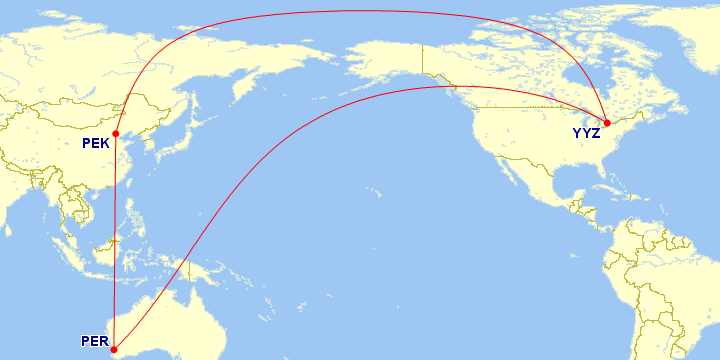
The African Hopper
Last year, I wrote an article called Oddball Trips with Aeroplan, and one of the possibilities I had discovered was the criss-crossing network of African flights operated by, among others, Ethiopian Airlines, South African Airways, Turkish Airlines, and Brussels Airlines, throughout the continent. I dubbed this the “African Hopper”, and on this trip I wanted to explore the possibility of making it a reality.
After I wrote about my favourite tools and tricks for planning an Aeroplan Mini-RTW, reader Martin reached out to me to let me know of another tool that’s super useful for this kind of task: the Star Alliance FlightMap. Every city that’s served by a Star Alliance airline is on there, and you can click from one city to the next to string routes together.
I zeroed in on West Africa, where I intended to have a few layovers and potentially a stopover on my way from Toronto to Perth. There’s a pretty interesting web of Star Alliance routes in this part of the world, as seen in the below screenshots from the FlightMap:
I use the Google Search method to determine the flight schedules of the flights linking Dakar, Conakry, Abidjan, Bamako, and Ouagadougou, as well as the onward flights to Istanbul and Addis Ababa. Eventually, I settle upon a Dakar–Conakry–Abidjan sequence, which gives me decent long layovers in the capitals of Senegal and Côte d’Ivoire and allows me to use my stopover in the capital of Guinea.

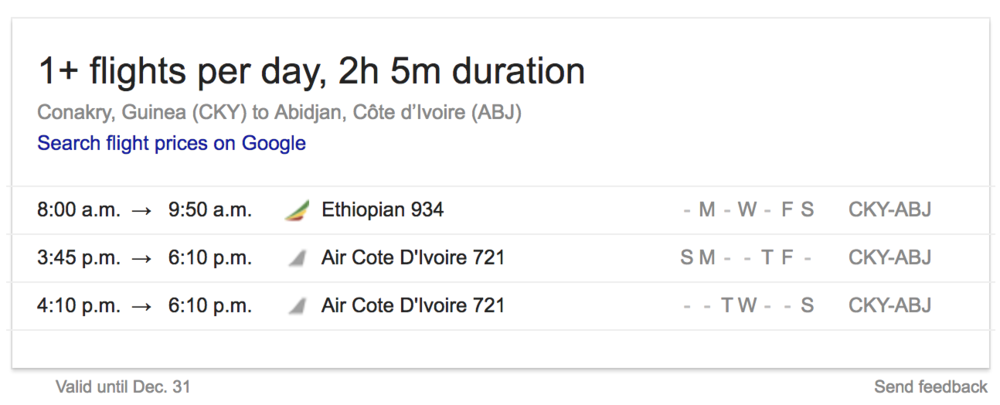
I could’ve gone with Dakar–Bamako or Dakar–Conakry–Ouagadougou, but the scheduling wouldn’t have been optimal – in both cases, one of the stops would’ve been a very short affair of only a few hours, which isn’t quite as much fun as a long layover.
To get to Dakar, I intend to fly South African Airways from Washington, DC. Meanwhile, I’ll be catching the Turkish Airlines flight out of Abidjan and into Istanbul. As you can imagine, not many people are redeeming their miles on flights in this part of the world, so availability was excellent. I was therefore satisfied with this portion of the trip, which looks as follows:

Air Canada // YYZ–IAD // BusinessSouth African // IAD-DSS // Business // 13 hr layover in DakarBrussels // DSS–CKY // Business // 3 day stopover in ConakryEthiopian // CKY–ABJ // Business // 12 hr layover in AbidjanTurkish // ACC–IST // Business
The United Island Hopper
Let’s be real. There was only ever one way to truly attain Goal #3 above – the goal of using Aeroplan to visit hard-to-reach places – and that’s the United Island Hopper.
Operated three times a week, United Airlines Flights 154 and 155 hop through seven islands in the Pacific Ocean over the course of 20 hours, providing these islands with a crucial link to the outside world. For anyone who likes aviation and flying, the United Island Hopper is a major bucket list item.
Starting in Honolulu, the westbound Flight 154 makes stops in Majuro and Kwajalein Atoll (both part of the Marshall Islands), followed by the islands of Kosrae, Pohnpei, and Chuuk (all part of the Federated States of Micronesia), before arriving in the US territory of Guam. Meanwhile, the eastbound Flight 155 traces the reverse path, and I was aiming to make it part of my return journey home from Beijing.

The problem with booking the Island Hopper as a through-trip, though, is that you don’t actually get to spend any time on the islands. Flights 154 and 155 stop in each of the islands for between 30 and 60 minutes, which is barely enough time to get off the plane to stretch your legs.
To my delight, though, as I was doing a cursory Google Search of the flight schedules…

…I found that United operates even more frequencies across these islands that I wasn’t initially aware of! Indeed, as you can see, while Flights 154 and 155 operate on Mondays, Wednesdays, and Fridays, there’s another Island Hopper service, Flights 132 and 133, that operate on Sundays and skips over Kwajalein Atoll.
What’s more, there’s a third set of flights – Flights 176 and 177 – that operate solely between Guam, Chuuk, and Pohnpei. And by mixing and matching among the eastbound flights in each pairing, I was able to construct an itinerary that gave me a 14-hour layover in Chuuk and a near-perfect 23.5-hour layover in Pohnpei. Boom!
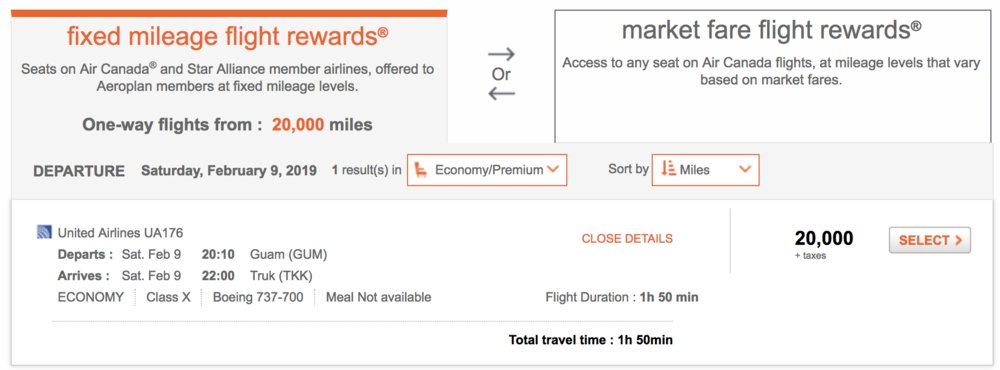
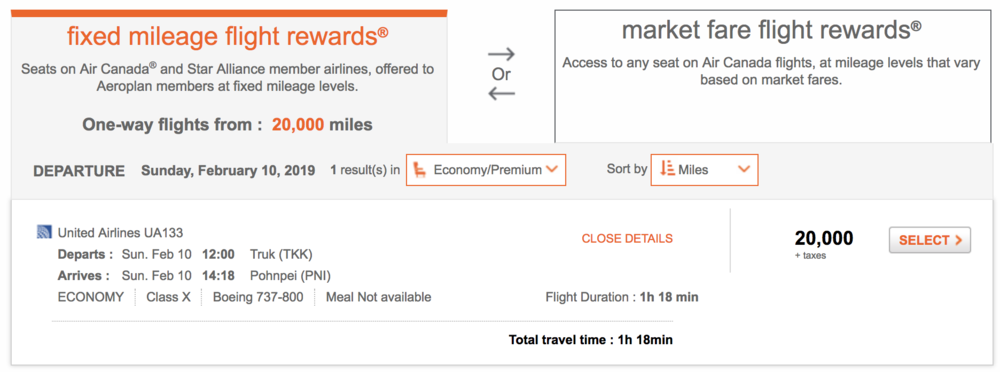
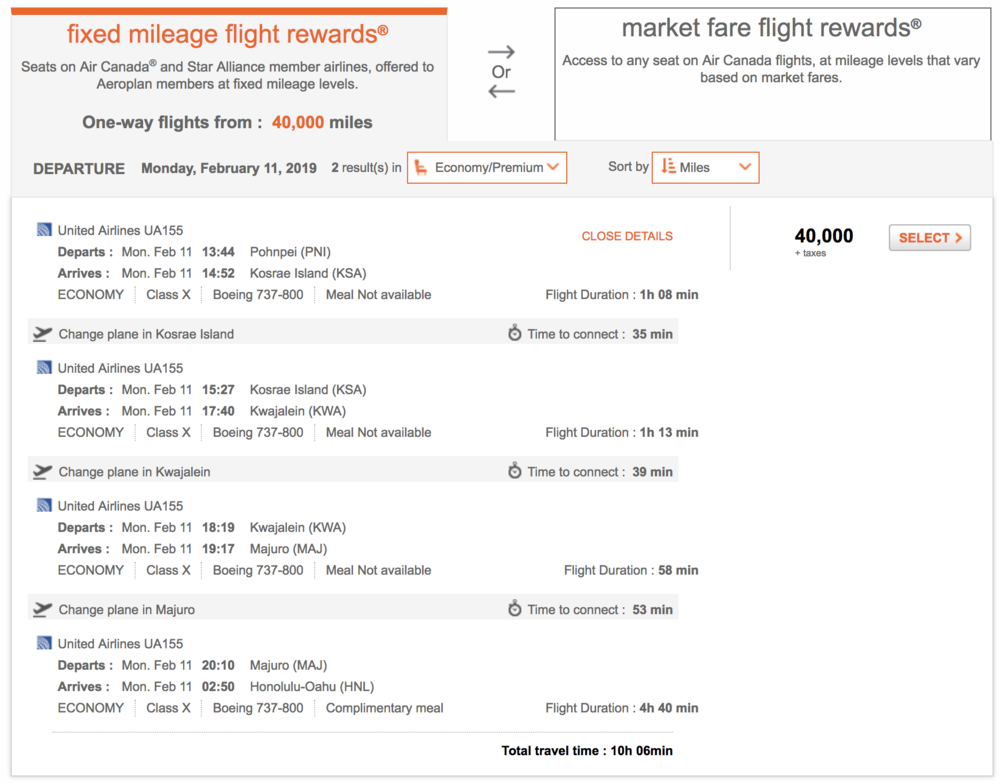
United doesn’t seem to release any business class award space on these flights, at least not until a few weeks out. That’s alright, though, because I’m totally happy to satisfy my obsession with remote islands in economy class!
The Final Pieces
With a few exciting excursions fixed in place, I now set about to finish off the route planning. I needed to get from Istanbul, the tail end of my African Hopper journey, to Perth, my point of turnaround. Using the Aeroplan search engine, I easily found availability on a mix of Turkish Airlines’s fantastic business class and Singapore Airlines’s new Boeing 787-10 business class, which I’m excited to try out.
Then, I needed to take care of the real objective of this trip – Beijing. That was also simple enough: Perth to Beijing via Singapore came up easily via an Aeroplan search, while Beijing to Guam – the starting point of the United Island Hopper – would be accomplished via a connection in Hong Kong.
It was at this point that I noticed I could actually extend my island-hopping travails even further to Saipan (the capital of the Northern Mariana Islands) or Koror (the largest town in Palau), both of which are connected to Guam by United Airlines as well. However, the scheduling didn’t quite work for either of those options, and it would’ve been moot anyway, for reasons you’ll see below.
Anyway, that just left me with figuring out how to get home from Honolulu. I was delighted to find business class availability on Air Canada to Vancouver, followed by an overnight flight back home to Toronto. And so my full itinerary had been sketched out:

Air Canada // YYZ–IAD // BusinessSouth African // IAD-DSS // Business // 13 hr layover in DakarBrussels // DSS–CKY // Business // 3 day stopover in ConakryEthiopian // CKY–ABJ // Business // 12 hr layover in AbidjanTurkish // ACC–IST // Business // 16 hr layover in IstanbulTurkish // IST–SIN // BusinessSingapore // SIN–PER // Business // 2 day stopover in PerthSingapore // PER–SIN // BusinessSingapore // SIN–PEK // Business // 7 day stopover in BeijingAir China // PEK–HKG // BusinessUnited // HKG–GUM // Economy // 14 hr layover in GuamUnited // GUM–TKK // Economy // 14 hr layover in ChuukUnited // TKK–PNI // Economy // 23 hr layover in PohnpeiUnited // PNI–KSA // Economy United // KSA-KWA // Economy United // KWA–MAJ // Economy United // MAJ-HNL // Economy // 14 hr layover in HonoluluAir Canada // HNL–YVR // BusinessAir Canada // YVR–YYZ // Business
I ring up the Aeroplan contact centre. Naturally, it takes a good amount of time to tell the agent exactly which flights I want, building up the itinerary from scratch. About an hour later, she puts me on hold and calls her ticketing department to issue the ticket…
…only to come back and say, “Sir, you can’t have more than 16 segments on a single ticket – this has 19 segments!“
Back to the Drawing Board
I push for a supervisor in order to ask for a one-time exception, but I’m told that it’s a “technical impossibility” to issue a ticket with more than 16 segments. Apparently that’s just how plane tickets work in general – no ticket has ever been issued with more than 16 segments. And much to my frustration, multi-segment flights like United Flight 155 must be counted separately as individual segments too.
Truth be told, I had heard about this limitation before, but I had always wondered if it was actually true, since I had never tried anything like this before. It sure seems like an awfully arbitrary and antiquated restriction, but sadly that’s the way it is, and there was nothing the supervisor or anyone else could do about it.
I now needed to find a way to cut down on three of my segments.
Over in Micronesia, there was no wiggle room – the United Island Hopper was a big part of this expedition, and I wasn’t going to cut corners by skipping islands here and there. I also couldn’t really do anything around Perth or Beijing, since the inclusion of those cities was foundational for this trip.
In the end, I had to do two things. First, I changed the origin of the trip so that I would begin and end in Newark instead of Toronto. This way, I could fly out to Africa straight from Newark, and I could also fly from Honolulu to Newark on a direct flight at the end (albeit in economy class). This reduced the segment count by two, and meant that I’d have to book a separate positioning flight between Toronto and Newark, which is a small price to pay considering the mammoth trip that’s at stake here.
Second, I reduced the number of African stops from three to two, lowering the segment count by one more. The only flight between Newark and West Africa goes to Abidjan, so the Ivorian capital would have to be one of the stops. I then needed a one-stop routing from Abidjan to Istanbul to finish “connecting the dots”, so it was time to look back at the Star Alliance FlightMap…
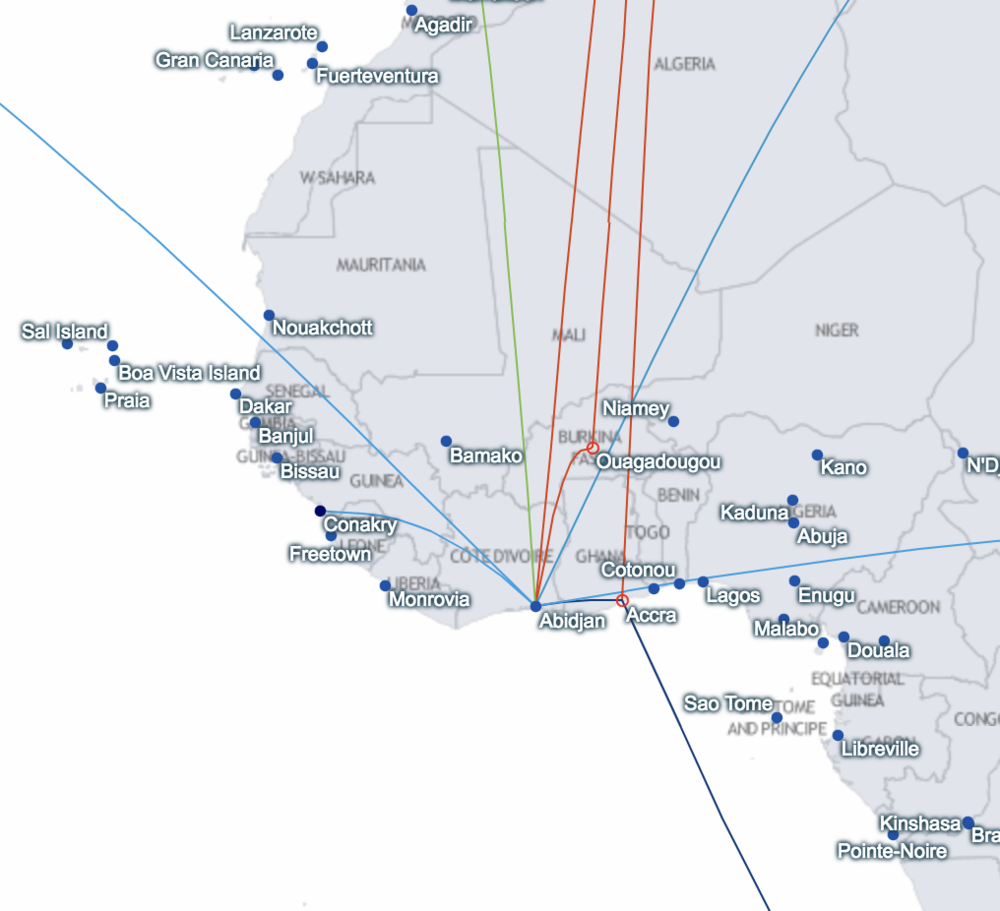
The best option, as it turned out, was one I hadn’t considered before: Accra, Ghana. Not only did the flight schedule work out perfectly for a long layover in Abidjan followed by a stopover in Accra, but upon further research, Accra actually seems like a very interesting place to visit and a fantastic place for my initial port of call in West Africa. It even has a newly-opened Marriott hotel, where I will definitely be looking to redeem points for my stay.
Sadly, the two-stop routing in Africa isn’t much of a “hopper” anymore, but there’s nothing further I can do. My revised itinerary now looks as follows, falling just within the pesky 16-segment limit:
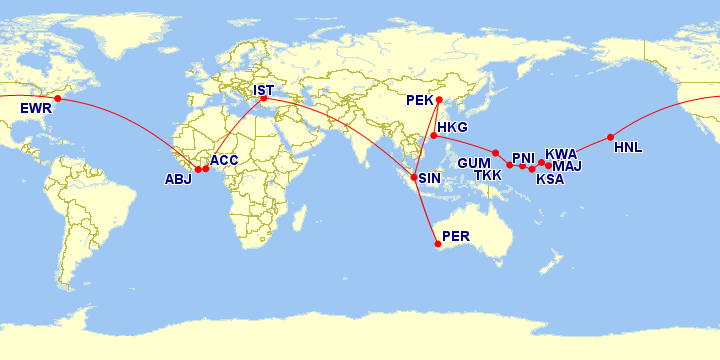
Ethiopian // EWR–ABJ // Business // 14 hr layover in AbidjanSouth African // ABJ–ACC // Business // 3 day stopover in AccraTurkish // ACC–IST // Business // 19 hr layover in IstanbulTurkish // IST–SIN // BusinessSingapore // SIN–PER // Business // 2 day stopover in PerthSingapore // PER–SIN // BusinessSingapore // SIN–PEK // Business // 7 day stopover in BeijingAir China // PEK–HKG // BusinessUnited // HKG–GUM // Economy // 14 hr layover in GuamUnited // GUM–TKK // Economy // 14 hr layover in ChuukUnited // TKK–PNI // Economy // 23 hr layover in PohnpeiUnited // PNI–KSA // Economy United // KSA-KWA // Economy United // KWA–MAJ // Economy United // MAJ-HNL // Economy // 14 hr layover in HonoluluUnited // HNL–EWR // Economy
Since the origin had been changed to Newark, I was now working with a revised MPM of 18,633 miles. The outbound journey clocks in at 16,042 miles, and the return journey at 17,879 miles. I’m happy with that!
The Aeroplan call centre processed this without issue, and the taxes and fees came ultimately came to $437.40. Having eliminated all the Air Canada flights with my last-minute tweaks, I ensured that the itinerary was fully surcharge-free, and so that $437.40 consists solely of the airport taxes incurred by 16 separate takeoffs and landings across nine countries in five continents. Well worth it, if you ask me.
Conclusion
Côte d’Ivoire. Ghana. Turkey. Australia. Singapore. China. Guam. Federated States of Micronesia. Marshall Islands. Hawaii.
It hasn’t quite hit me yet that I’ve actually booked and will be going on a trip like this. I still need to do a few things, like setting up some ExpertFlyer alerts for those segments in United economy class in case business class opens up, and filling out visa applications for certain countries. But one thing’s for sure: the fact that this trip can all be booked for 160,000 Aeroplan miles is nothing but downright crazy.
It all comes down to something I routinely emphasize: understand its inner workings, and Aeroplan can be an insanely powerful program. Of course, you don’t have to take things nearly as far as I did in this trip in order to extract spectacular value out of your miles; even just by taking advantage of Aeroplan’s stopover policies, you’re already coming out ahead.
And ultimately, who knows what’ll happen to Aeroplan after June 2020? If you have a stash of Aeroplan miles, it may be time to start thinking about a few “last hurrahs” of your own.



